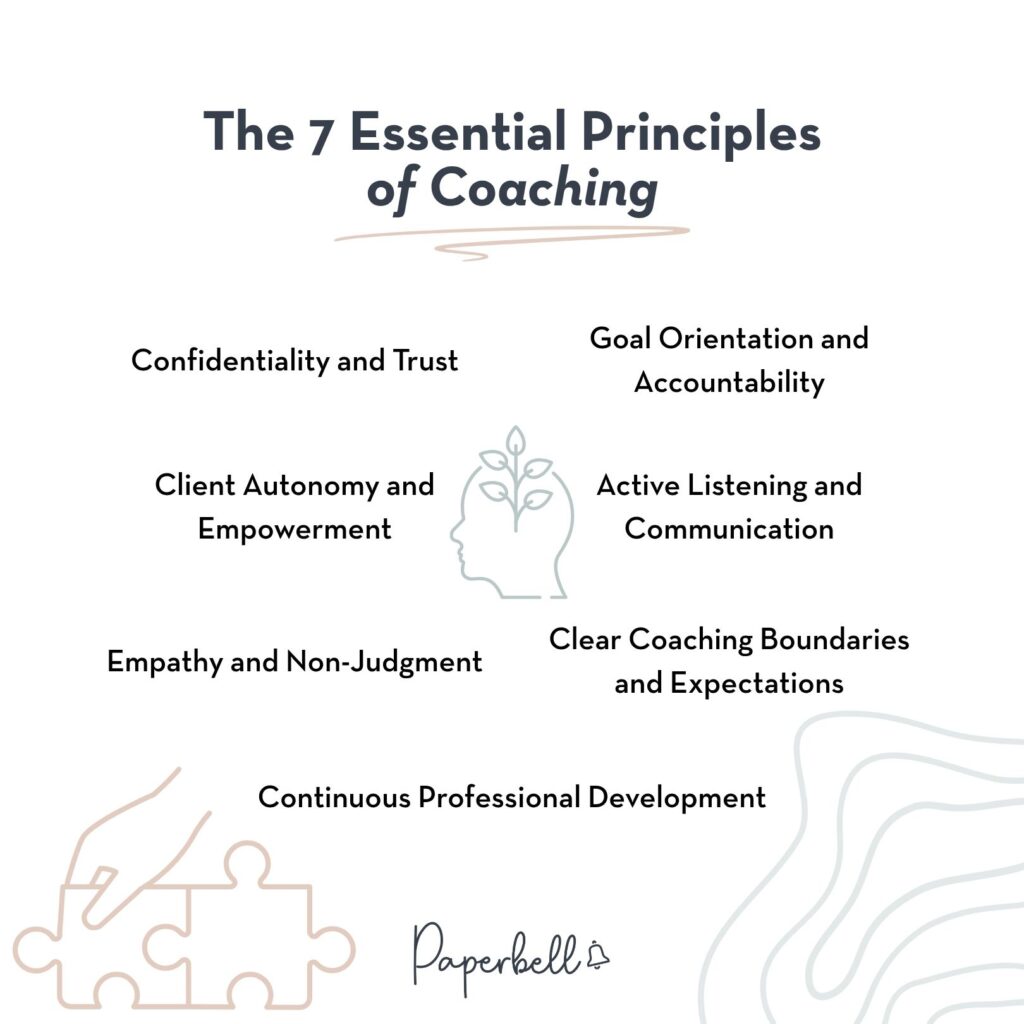As established or new coaches, having coaching guidelines isn’t just nice to have. It’s necessary.
These guidelines help you demonstrate professionalism and navigate complex client relationships.
In this guide, we’ll look at the fundamental principles of coaching and how to create a framework that aligns with your values and coaching principles.
What is a Coaching Guideline?
A coaching guideline is a set of principles, boundaries, and standards that define how you run your coaching practice. They help you be consistent, build trust, and create a safe space for transformation so you can deliver results.
Guidelines for effective coaching practices outline what clients can expect from you, what you expect from them, and how you’ll work together to achieve their goals.
They cover everything from coaching agreements to communication protocols, goal-setting processes, and coaching session structures.
The 7 Essential Principles of Coaching
These principles ensure every coaching relationship grows in mutual understanding and respect. They are ethical practices that coaching governing bodies (such as the International Coaching Federation – ICF) and communities expect coaches to have.
Principle 1: Confidentiality and Trust
Confidentiality is a key part of every successful coaching relationship.
Your clients need to know that what they share with you stays with you. This creates the psychological safety for honest self-exploration.
- State your confidentiality policy in your coaching agreement
- Explain any legal exceptions (e.g., harm to self or others)
- Remind clients regularly that your sessions are a safe space for open dialogue.
Example: Executive coach Sarah’s client shared concerns about their CEO and company culture while considering resignation. Sarah maintained strict confidentiality, and this created a safe space for honest exploration and ethical decision-making.
Principle 2: Client Autonomy and Empowerment
Coaching is about empowering clients to find their own answers and develop deeper self-awareness.
This principle ensures clients identify areas that need improvement, develop problem-solving skills, and take control of their own lives.
- Practice open-ended conversations that promote self-reflection
- Don’t give direct advice
- Help clients identify their patterns and triggers
Example: Life coach Michael didn’t give work-life balance solutions. Instead, he asked, “What would perfect balance look like?” helping his client discover personal solutions and recognize their people-pleasing patterns.
Principle 3: Empathy and Non-Judgment
Genuine empathy without judgment creates a safe environment where clients feel heard and accepted.
This coaching principle involves understanding your client’s perspective and emotions without imposing your own values, opinions, or biases on their experience.
- Reflect back what you hear and feel from your client
- Regularly examine your own biases and set them aside
- Validate their emotions
- Focus on understanding rather than evaluating your client’s choices
Example: Career coach Jennifer’s client wanted to leave corporate for art. Jennifer showed empathy: “This creative calling feels important, and there’s financial uncertainty. Help me understand what this means to you.”
Principle 4: Goal Orientation and Accountability
Effective coaching focuses on specific outcomes and holding clients accountable for the actions they commit to taking.
- Help clients set SMART goals
- Establish regular check-ins
- Share resources that get them to act
- Create systems for tracking progress and celebrating achievements
Example: Business coach David helped an entrepreneur turn “grow my business” into specific milestones—20% revenue increase, two new team members, and one product launch.
Principle 5: Active Listening and Communication
Effective communication in coaching includes active listening, powerful questioning, and constructive feedback.
These interconnected skills promote deeper thinking, personal development, and meaningful progress towards goals.
- Listen for both words and emotions
- Ask introspective questions that prompt deeper exploration
- Give specific and actionable feedback tied to client goals
Example: Relationship coach Lisa noticed her client’s frequent “should” statements, asked powerful questions about language patterns, then gave feedback about energy shifts when language changed, promoting authentic self-discovery.
Principle 6: Clear Coaching Boundaries and Expectations
Professional boundaries protect the coach and client relationship while creating a structured environment for growth.
This includes clarifying roles, session logistics, communication protocols, and other coaching rules.
Define the following from the start:
- Your availability
- Communication method (your options and client preferences)
- Scope of coaching engagement
- Specific deliverables involved
- Cancellation and refund policies
Example: Wellness coach Amanda established clear between-session boundaries: brief emails are okay, long discussions are reserved for sessions. When one client sent daily emotional emails, Amanda redirected while offering crisis resources.
Principle 7: Continuous Professional Development
If you want to serve your clients at their best, commit to ongoing development.
Focus on creating opportunities to build meaningful connections and stay updated on best coaching practices and models.
- Regularly review your skills and knowledge gaps
- Invest in relevant training and certifications
- Seek supervision or mentorship
- Join coaching communities and networks
Example: Leadership coach Robert had tech industry clients. He invested in his continuous development, such as getting personalized training, joining tech groups, and seeking mentorship from tech coaches to serve clients better.

The Coach’s Role
As a coach, here’s what your role is like when it comes to coaching guidelines:
How to Introduce Guidelines at the Beginning of a Coaching Relationship
The first session sets the tone for your entire coaching relationship.
Explain your guidelines and how they aren’t restrictions but frameworks that make transformation possible. Walk through each guideline, explain the reasoning behind it, and invite questions or concerns.
Make this conversation collaborative rather than one-sided, and be open to reasonable modifications that serve both of you. Clients need a supportive environment to feel safe and supported.
Including Guidelines in Your Coaching Agreement
Your coaching agreement should outline your session structure, confidentiality policies, coaching principles, and mutual expectations.
This isn’t just legal protection. It’s a reference document that both you and your client can refer to throughout your work together.
A tool like Paperbell makes this process seamless by allowing you to upload standardized agreements that can be easily customized for each client.
When and How to Review Guidelines During the Coaching Relationship
Guidelines aren’t “set it and forget it” documents.
Schedule regular check-ins to review how the coaching relationship is working and if any adjustments are needed. This might be monthly or quarterly, depending on the length of your coaching engagement.
Also, be prepared to review guidelines when challenges arise. If a client frequently cancels sessions or struggles with assignments, return to your original agreements and problem-solve together.
Handling Guideline Violations
When guidelines are crossed, address the situation promptly and directly.
Approach these conversations with curiosity rather than judgment. Often violations signal unmet needs or misunderstandings rather than deliberate disrespect.
Use these moments as coaching opportunities. What can you both learn from this situation? How can you prevent similar issues in the future?
The 5 C’s of Coaching in Your Guidelines
Here are the 5 C’s to guide your coaching guidelines:
- Clarity: Setting Clear Expectations from the Start
Clarity eliminates confusion and creates a solid foundation for your coaching relationship.
Be specific about session frequency, duration, and format. Explain your coaching approach and what clients can expect from you.
Tip: Create a welcome packet that outlines your coaching process, includes frequently asked questions, and provides resources for getting the most out of coaching.
- Connection: Building Rapport Within Appropriate Boundaries
Strong coaching relationships require genuine connection, but this must be balanced with professional boundaries.
You’re not your client’s friend, therapist, or consultant. You’re their coach.
Tip: Establish warm but professional communication. Share enough about yourself to build rapport without shifting focus away from your client.
- Curiosity: Space to Explore Within Structure
Curiosity drives self-discovery but needs structure to be effective.
Create space to explore that’s focused on your client’s goals and desired outcomes.
Tip: Develop a list of powerful questions organized by coaching themes (career transitions, leadership development, relationship challenges). Have it with you during sessions.
- Commitment: Both Parties Must Be All In
Both the coach and the client must be committed to the process for coaching to work.
This means showing up prepared, following through on agreements, and staying engaged even when the work gets tough.
Tip: Check in on commitment levels on both sides. If you see client engagement dropping, address it.
- Confidentiality: Building Trust Through Privacy
Confidentiality isn’t just about keeping secrets.
It’s about building trust and creating safety for vulnerable sharing and growth.
Tip: Remind clients their disclosures are safe, especially before sensitive conversations.
Create Your Own Coaching Guidelines: A Step-by-Step Guide
Want to create your coaching guidelines? Here’s how:
Your Coaching Style and Core Values
Before you write guidelines, get clear on your coaching philosophy and core values.
- What do you believe about human potential?
- How do people change and grow?
- What role do you play in that process?
Your guidelines should reflect your unique coaching style while following universal best practices and ethical standards for coaching. This assessment becomes a foundation for your business plan and ensures that your coaching guidelines align with your broader vision and target market.
Your Non-Negotiables vs. Flexible Areas
Some guidelines are non-negotiable for your practice, while others can be adapted to client needs or circumstances.
Identify what you’re willing to be flexible about and what coaching boundaries are firm.
For example, confidentiality should be non-negotiable, and session frequency can be flexible based on client preferences and budget.
Write Guidelines That Reflect You
Use clear language that reflects you while being professional. Your guidelines should feel like a relatable extension of who you are as a coach.
Include the reasoning behind important coaching protocols so clients understand the value, not just the rules.
Test and Refine Your Guidelines Based on Client Feedback
Your initial guidelines are a starting point, not a final stop.
Pay attention to recurring questions, challenges, or misunderstandings that arise with clients. Use this feedback to refine and improve your coaching guidelines over time.
Use Paperbell to Easily Share and Manage Your Guidelines with Clients

Paperbell is an all-in-one coaching software that makes this process seamless.
You can upload standard agreements, forms, and coaching contracts, and they become instantly available to new clients upon onboarding.
But there’s more. You can:
- Automate email reminders and call notifications
- Create a no-code professional website
- Set up different types of coaching packages
- Accept payments for your offers
- Track client activities and payments
Ready to simplify your coaching processes? Try Paperbell for free and see how it’ll make running your coaching business easy and seamless.
FAQ Coaching Guidelines
What is coaching guidance?
Coaching guidance refers to the framework and support a coach provides to help clients achieve their goals. It includes coaching standards, instructional strategies, and principles that govern the coaching relationship to get results.
What are the 5 C’s of coaching?
The 5 C’s of coaching are clarity, connection, curiosity, commitment, and confidentiality.
What are the 7 P’s of coaching?
While interpretations vary, the 7 P’s are commonly: confidentiality, empowerment, empathy, goal-setting, active listening and communication, boundaries, and continuous learning.
How often should I review my coaching guidelines?
Review your coaching guidelines at least annually or whenever you notice recurring issues in your practice. Also, review them when you add new services, change your coaching focus, or receive feedback that suggests you need to update them.
Using Coaching Guidelines Effectively
These essential principles of coaching guidelines will help you create safety for vulnerability, structure for professional growth, and clarity for client progress.
Want to simplify how you run your coaching practice? Paperbell makes it easy to set up packages, onboard clients, and manage your coaching agreements and guidelines, so you can focus on what you do best. Try Paperbell for FREE today.










